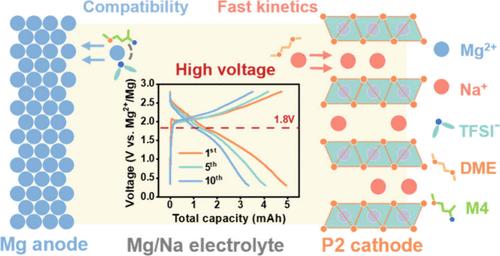用于无氯镁钠混合电池器件的p2型锰基氧化物阴极
IF 18.2
1区 材料科学
Q1 CHEMISTRY, PHYSICAL
引用次数: 0
摘要
p2型锰基氧化物具有高电压和开放层状结构,有望用于高能量密度可充电镁电池(RMBs),但它们受到Mg2+扩散缓慢和缺乏适应性无腐蚀性电解质的影响。本文开发了一种含有胺螯合剂的双盐电解质的镁钠混合电池,以实现电压增强和可逆阴极操作。Na+提高了高压下的反应动力学,而胺螯合剂提高了镁阳极界面相容性。该电池在20ma g-1下可达到150mah g-1和1.8 V,在50 mA g-1下100次循环时容量保持率为66.8%,优于大多数氧化物阴极,这是由于恒流间歇滴定技术和弛缓时间分布分析证明了高电压区域动力学的改善。此外,还首次展示了镁基袋状电池,可提供~ 162 Wh kg-1(基于阴极活性质量)。这项工作验证了氧化物基镁电池的实用潜力,并为高性能镁电池的开发建立了关键的设计原则。本文章由计算机程序翻译,如有差异,请以英文原文为准。

P2-Type Mn-Based Oxide Cathode for Chlorine-Free Mg–Na Hybrid Battery Devices
P2-type manganese-based oxides possess high voltage and open layered structures, showing promise for high-energy-density rechargeable magnesium batteries (RMBs), but they suffer from sluggish Mg2+ diffusion and a lack of adaptable noncorrosive electrolytes. Herein, a Mg–Na hybrid battery with a dual-salt electrolyte containing amine chelators is developed to enable voltage-enhanced and reversible cathode operation. Na+ improves the reaction kinetics at high voltage, while amine chelators enhance Mg anode interface compatibility. The battery achieves 150 mAh g–1 and 1.8 V at 20 mA g–1, with 66.8% capacity retention over 100 cycles at 50 mA g–1, outperforming most reported oxide cathodes due to improved kinetics in the high-voltage region, as evidenced by the galvanostatic intermittent titration technique and the distribution of relaxation time analyses. Moreover, a magnesium-based pouch cell is also demonstrated for the first time, delivering ∼162 Wh kg–1 (based on the cathode active mass). This work verifies the practical potential of oxide-based magnesium batteries and establishes a key design principle for the development of high-performance RMBs.
求助全文
通过发布文献求助,成功后即可免费获取论文全文。
去求助
来源期刊

ACS Energy Letters
Energy-Renewable Energy, Sustainability and the Environment
CiteScore
31.20
自引率
5.00%
发文量
469
审稿时长
1 months
期刊介绍:
ACS Energy Letters is a monthly journal that publishes papers reporting new scientific advances in energy research. The journal focuses on topics that are of interest to scientists working in the fundamental and applied sciences. Rapid publication is a central criterion for acceptance, and the journal is known for its quick publication times, with an average of 4-6 weeks from submission to web publication in As Soon As Publishable format.
ACS Energy Letters is ranked as the number one journal in the Web of Science Electrochemistry category. It also ranks within the top 10 journals for Physical Chemistry, Energy & Fuels, and Nanoscience & Nanotechnology.
The journal offers several types of articles, including Letters, Energy Express, Perspectives, Reviews, Editorials, Viewpoints and Energy Focus. Additionally, authors have the option to submit videos that summarize or support the information presented in a Perspective or Review article, which can be highlighted on the journal's website. ACS Energy Letters is abstracted and indexed in Chemical Abstracts Service/SciFinder, EBSCO-summon, PubMed, Web of Science, Scopus and Portico.
 求助内容:
求助内容: 应助结果提醒方式:
应助结果提醒方式:


